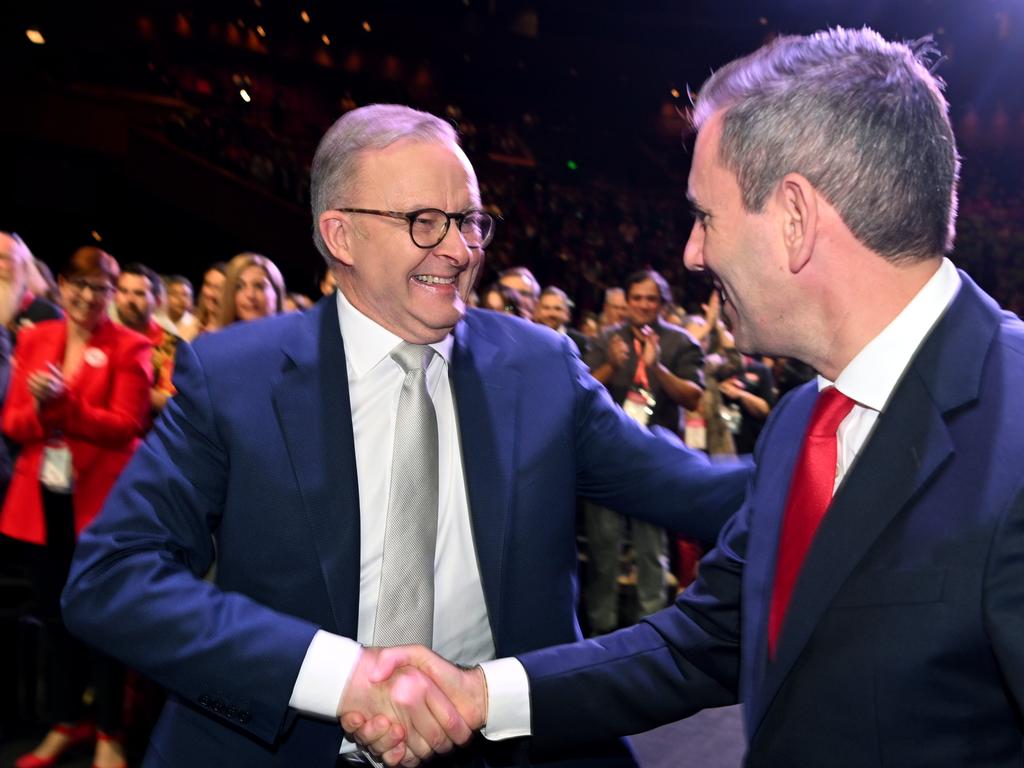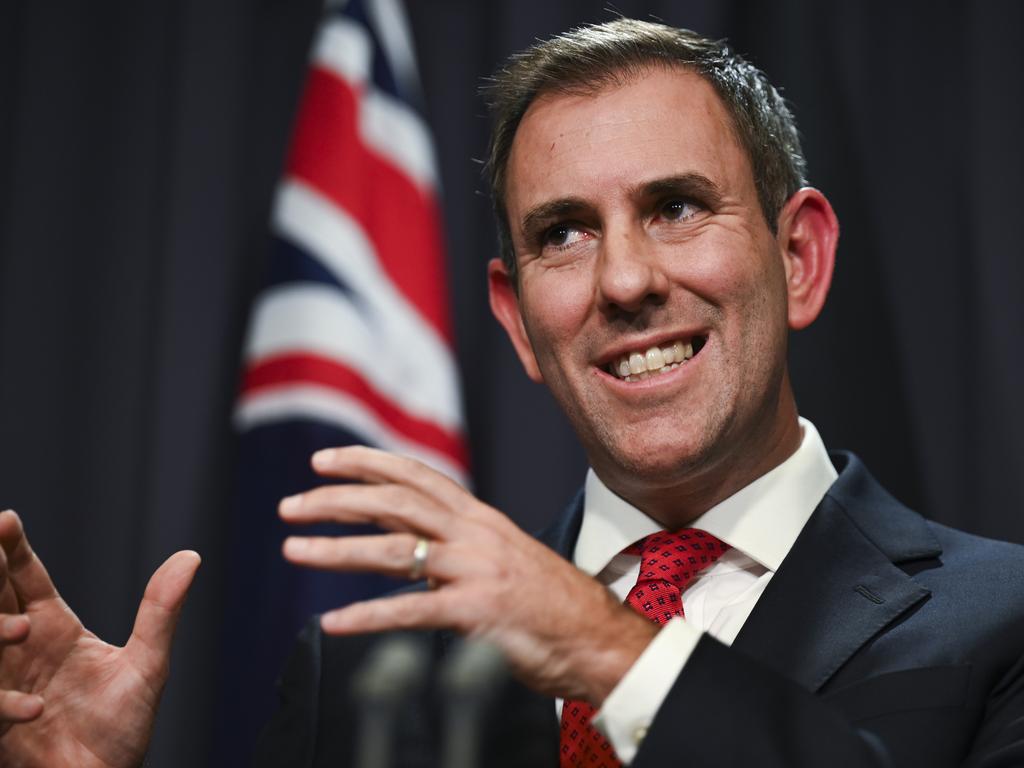Jobs galore but a big productivity flaw in Dr Jim’s thinking
Treasurer Jim Chalmers unveiled the Working Future white paper yesterday. We unpack what it means for inflation and the underemployed.

At last year’s Jobs and Skills Summit, Treasurer Jim Chalmers made a big promise.
He said the Albanese government would deliver an employment white paper designed to future-proof the nation’s workforce – something that’s only happened twice before.
It came at a unique economic moment:
Within the month, inflation would be climbing at its fastest rate since the early 1990s.
The Reserve Bank, attempting to get it under control, was halfway through a brutal, year-long run of interest-rate rises.
The cost of living was skyrocketing while unemployment had plunged to record lows.
On Monday, the Treasurer unveiled the 252-page white paper.
Dr Chalmers said it was about “taking the big shifts that we are seeing in our economy and our society and making it work for Australians and not against them.”
The Australian’s Tom Dusevic said Labor spent a year putting the document together.
“It joins the dots for all the other policies that feed into it: education and training, the decarbonisation agenda, migration and social inclusion, industry development. They all pool in to the accumulated brainpower of what‘s on display in this paper.
“The precursors to this are two other Labor documents: the 1945 Full Employment white paper that was done by the Curtin and then Chifley governments. And it basically set out the ambitions for Australia from 1945 until the early 70s.
“This is essentially a mission statement for what a government wants to achieve. Then coming out of Paul Keating‘s recession that we had to have in the early 90s, that followed the huge restructuring the economy underwent in the early 80s, Bob Hawke and Keating remade the economy, opening it up to the world.
“That led to real big changes and huge disruptions for Labor‘s own working people. They bore the brunt of opening up the economy and getting rid of tariffs and other forms of industry protection and privatisation.
“So that employment White Paper was known as Working Nation and it looked for a whole way of really getting the most damaged workers in that sense, the ones who had been required to move industries, move locations. And it was set about trying to make a labour training and welfare system that could essentially transition people away from unemployment with a real big focus on the long-term unemployed.”
Now the Government faces a new challenge.
Many industries and sectors are struggling with crippling labour shortages and record job vacancies.
But the government doesn’t see that as a bad thing – quite the opposite.
WHAT’S JIM CHALMERS’ VISION FOR JOBS?
Jim Chalmers said the vision is “a secure, fairly paid job for everyone who wants one and a qualified worker for every employer who needs one. We want to help workers find great opportunities and we want to help employers find great workers so that we can prosper together as a nation.”
But in a situation where there are more jobs than there are people looking for them, the government has a solution for getting Australians into work.
HOW MUCH CAN PENSIONERS AND VETERANS WORK?
From January 1, pensioners and eligible veterans will be able to earn more without penalty.
That means about 138,000 people receiving Jobseeker, Youth Allowance, ABSTUDY, or disability and carer payments will keep more of their welfare benefits.
Here’s Social Services Minister Amanda Rishworth: “There‘s never been a better time with our low unemployment figure for those that have been excluded from the workforce to get the opportunity to try work.”
The thinking is that having veterans and welfare recipients in the workforce will help to plug those immediate gaps.
JOB CHANGES FOR CARERS, NDIS CLIENTS, INDIGENOUS AUSTRALIANS
We have full unemployment, so anyone who can’t get a job in what Tom Dusevic called these “extreme wonderful conditions are people who are disadvantaged in the labour market, people, people with disabilities, Indigenous Australians … and then there are also people who … might be caring for children and wanting to work a few more days a week or they may be in a situation where it just doesn‘t make sense to leave a payment like Jobseeker because you are also getting lots of different concessions.”
TAX IMPLICATIONS FOR WORKING PARENTS
Other families have made the calculation that if a second partner works, they’ll be pushed into a higher tax bracket.
“You often get these anomalies that are very that stop people participating in the workforce. So the government is trying to address those structural factors in a whole heap of ways.”
The Treasurer’s full-employment plan is at odds with the position of new Reserve Bank Governor, Michelle Bullock.
The RBA says more people in work equals more income being pumped into the economy – and that just makes it harder to bring inflation back down to acceptable levels.
ARE INTEREST RATES GOING TO RISE?
Business groups reckon it’ll fuel inflation and push more people into insecure employment.
Tom Dusevic doesn’t think it will.
“It all depends on the deal that the Treasurer strikes with Michelle Bullock on the statement on the conduct of monetary policy … what the Government expects of the Reserve Bank in doing this.
“On one hand, Jim Chalmers is speaking to his Labor constituency, not only in the unions but more broadly across the community, saying he won‘t be satisfied until every Australian who wants to work can work as many hours and be in employment as there are willing and able workers.
WHAT’S THE RESERVE BANK’S GOAL?
“The Reserve Bank needs very tight data, very tight goals that it needs to work towards because it‘s trying to balance low unemployment with low inflation and a stable currency. So it needs some real strong definitions.
“And what it reaches for is a very technical definition of full employment, which is known as the non-accelerating inflation rate of unemployment or the NAIRU, which we have heard about a lot in recent times.
“And essentially over time, the NAIRU can come down as long as we start addressing some of those structural challenges that stop people getting work. And that could be in workplace relations by making the workplace more flexible. It could be in improving people‘s skills. It could be in removing regulations. A whole big agenda there, too, to try and basically mean that your economy can run faster before it hits these inflation targets.”
The Reserve Bank‘s mandate is to have a flexible inflation target of 2 to 3 per cent on average over time.
AUSTRALIA’S POPULATION IS SURGING
Amid all this, the population is surging. Australia has grown by a record 600,000 people in a single year.
It was hoped the influx of international students and temporary workers would boost the struggling labour market.
And now we know the government’s banking on it.
MIGRATION CHANGES AHEAD
Labor is also considering a sweeping migration shake-up.
Home Affairs minister Clare O’Neil the goal is to “use every lever of national power to make sure we drive productivity growth so that Australians can get higher wages and better jobs.”
Harnessing the nation’s migrant workforce is just one of nine immediate actions outlined in the white paper.
Also on the agenda is a plan to establish economic partnerships with First Nations stakeholders.
That’s because there’s a big difference in the employment rates of Indigenous and non-Indigenous people.
WILL THE VOICE HAVE A ROLE IN JOBS?
It dovetails with another big issue: the upcoming referendum on an Indigenous Voice to Parliament.
Treasurer Jim Chalmers and Indigenous Australians Minister Linda Burney says they’ll ask the Voice for input on boosting Indigenous employment if Australians vote in favour of the Voice on October 14.
WHAT ABOUT APPRENTICESHIPS?
The government is looking closely at reforming skills qualifications, too.
It plans to accelerate apprenticeships in priority fields like net-zero and the care sector, and enable TAFE to deliver degree-like qualifications to workers employed in highly skilled fields.
Here’s Tom Dusevic again: “Industries are changing rapidly these days, particularly in the digital sphere. And so the government also wants to address that and make sure that all people, but particularly younger people, are ready for those jobs for the future.”
DON’T WE HAVE TO FIX PRODUCTIVITY FIRST?
The Government knows Australia has a problem with productivity – and that means there are “very difficult choices” ahead to improve competition, says Tom Dusevic.
“There‘s a lot of big business oligopolies.
“Then there are a whole range of issues with union intransigence.
“Productivity outcomes occur in a workplace. They don‘t sort of come from above. The government doesn’t at a stroke of a pen, say: ‘We need to have this level of productivity’, and go ahead and achieve it.
“What it does is it has a whole series of policies where it can nudge people toward making better decisions, working in smarter ways, being able to use your capital and labour in the best possible way. That is akin to the best practice that‘s happening at the global frontier.
“And that‘s what it needs to do, is it needs to make some really tough choices that by probably disrupting the few, the many can benefit.”
Tom says the ideological vision outlined in the white paper will inevitably clash with what’s practically possible from an economic perspective.
“The Prime Minister‘s heart and energy are in the right place. He wants an opportunity society where ‘no one is held back and no one is left behind’.
“But at heart, the economic program that he has is not going to deliver those outcomes for the broadest range of people.
“It might certainly deliver far better outcomes for particular constituencies and people in particular regions and industries, but it won‘t get us that uplift that we need across the board.
“And that‘s basically because we are still stuck into lots of old ways of doing things and with backsliding in industrial relations. We’re taking another expensive punt on industry policy.
“We‘ve been burnt in the past on that. There’s an argument that says no, this time it’s going to be different. But past experience tells us that we’re probably or a bit late to the game.”
This is an edited transcript of our daily news podcast The Front, where our journalists speak candidly about their stories. Hear it now on Apple Podcasts, Spotify or in The Australian’s app.






To join the conversation, please log in. Don't have an account? Register
Join the conversation, you are commenting as Logout